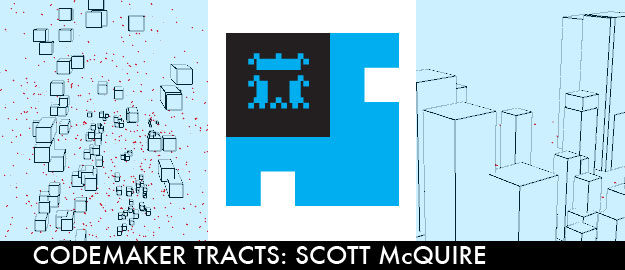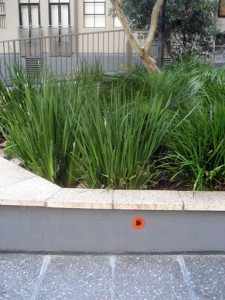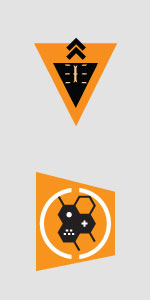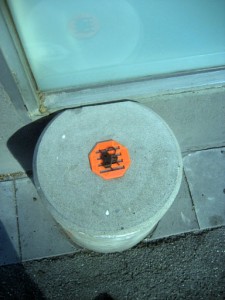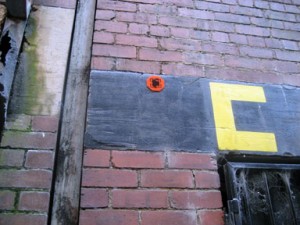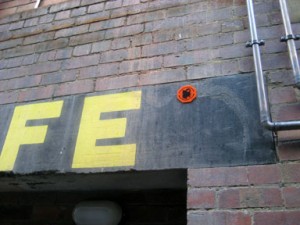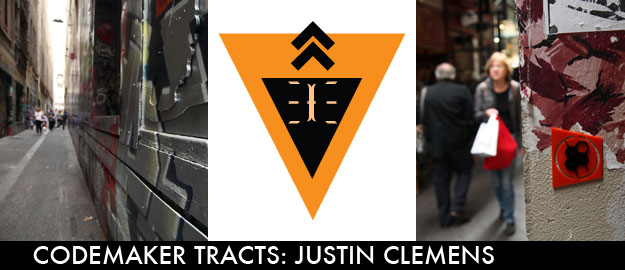[nggallery id=8]
Archive 6: Ecologies
Playing in the networked city
Scott McQuire ::: University of Melbourne
Metaphors are important. More than mere descriptions, they shape our relation to particular objects and environments. Back in the 1850s, when Paris was still a largely medieval city choking on its fast growing population, the dominant metaphor for the city was the human body. Paris was a sick body with poor circulation in need of radical surgery; its Prefect, Baron von Haussmann, soon supplied the remedy, as his reforms cut the old city apart with modern razor-straight boulevards. Within two generations the dominant urban metaphor had shifted in accord with the new realities of industrial life. For modernists such as Corbusier, cities were machines whose individual parts needed to be assigned specific functions and calibrated through central planning to form a single, smoothly operating unit. Today cities are frequently described as ecologies. The new metaphor indicates that cities are now recognized as a type of habitat, a constructed nature. Further, that like natural ecologies, the eco-systems of cities are complex and open-ended, involving the dynamic interplay of diverse elements, including topography, architecture, technologies and people, in ways which cannot be easily unified.
No matter how big cities get, living in them has always depended on local knowledge. When I first visited Tokyo at the height of the ‘bubble economy’ in the late 1980s— a moment when the speculative land value of the city was roughly equal to that of the entire United States—I was struck by how much this centre of global capitalism was still in fact a collection of distinct villages. Many areas in central Tokyo didn’t have street numbers. You needed to know the apartment buildings by name to navigate. Similarly, as a student in the early 1980s, before the Nieuwenhuysen reforms liberalized Melbourne’s licensing laws beyond recognition, I soon learnt where I could get a beer or glass of wine after hours: upstairs at the Waiter’s Club, at Stalactites, or down the next laneway at Tsakpina where I learnt to play backgammon. This sort of knowledge was passed on by word of mouth, forming an unofficial map of the city.
Urban ecologies are composed of these informal networks of knowledge, as much as by more official networks such as Melbourne’s grid of streets. But the ecological parameters of contemporary cities have been substantially transformed over the last decade by the widespread deployment of digital networks. Access to digital platforms is becoming pervasive in many cities, and the old dream of ‘anytime, anywhere’ is approaching realization. Moreover, media are fast becoming geomedia, in which place specific data and location-aware devices are creating the conditions for new practices of networked urban communication. The word of mouth that took me down a particular laneway in the 1980s can now have greater persistence and extension in time and space. Informal knowledge provided by multiple networks of city-dwellers can made available as dynamic digital data tagged to specific sites. How might this change the dynamics of public space? Can the lessons of peer-to-peer networks, with their new modes of collaborative production, participation and exchange, be extrapolated into peer-to-peer urbanism?
All too frequently the potential of new technologies is watered down reduced to tired old formulas. The use of digital data for commerce or security has become so routine that it often obscures other possibilities. Intimacy is now a currency being tracked, measured and sold back to us via social networking services. This is why experimental uses of digital networks for art and activism remains vitally important—not only because it can be fun, but because it reminds us that we can imagine alternative settings.
Playing in the contemporary networked city is a curious business. In the 1950s, play was seen as a possible counter-balance to excessive rationalization of urban space. Urban games such as those famously devised by the Situationists in Paris sought to encourage people to step off their usual pathways and to look at familiar spaces differently with an eye to appropriating them outside their official uses. The sociologist Richard Sennett argued that game playing in the city had political importance, first because it drew attention to the accepted rules of social life, and, second, because it created a potential space for their experimental reconstruction.
Of course, play itself has changed in the 21st century. Digital gaming has become a mega-industry, part of the so-called military-entertainment complex. Companies such as Microsoft, which pioneered the contemporary blurring of work and play, have given birth to digital sweatshops all over the world. Many digital platforms now depend on user-generated content which is appropriated by the platform owner. In this context, we can’t assume that play is inherently liberating, any more than we can assume that the internet is going to automatically ‘democratise’ society. Instead of generalizing, we need to ask specific questions. In what circumstances does urban play encourage us to step outside our tele-cocoons, explore our surrounds, and communicate more openly with strangers? Can play become a means of breaking through the barriers of ambient fear that so often paralyse social encounters in the contemporary city?
Urban public space has always been contested space. Different interests overlap, different agendas have to be negotiated. In 1967 French sociologist Henri Lefebvre published his famous tract ‘Right to the city’ which challenged the top-down ethos of modern urban planning, and instead argued that the capacity for a city’s inhabitants to actively appropriate the time and space of their surroundings was a critical dimension of modern social democracy. What might this right to the city mean in the context of a networked city? A city in which informal local practices remain important, but the bounds of the local can no longer be assumed to form a closed domain. Today the local is constantly reworked by the possibility of global extension through digital annotation. This is the new, uneven space of the city that urban gaming needs to explore.
© Scott McQuire 2010.
The Second Operative
The second operative has taken action for the Crossmedia Ecologist. Only hours after she had visited the Western Zones of the territory, more habitats for play were tagged by the second operative.
See the results here. And grab these tags before they disappear…
The Missing Link; or, The Virtual Ape in the Virtual City
Justin Clemens ::: University of Melbourne
The human species only became real — realized itself — when it became the most unreal of all animals. In the beginning was the virtual. This happened when the species contracted language, contracted it like a disease (as William Burroughs might say), or contracted it in a technically-binding way (as Thomas Hobbes might say). Language cuts the animal body from its immediate environment; language was the first and most determining of all virtual technologies. As soon as you start to speak, you can’t help but say things that aren’t. Words integrally transform the world, your body, your relationships to others. Things are damaged, destroyed, transformed in and by words. Words are world-destroying — which is why they are also world-creating. They tear possibility from what exists, and enable new sorts of impossible things to be envisaged, new sorts of tools to be invented, new sorts of dwellings to be constructed. Humans live in words much more than in places or, rather, every place is already a word-place too. This is the reason no-one will ever find any remains of the so-called ‘Missing Link’: the Missing Link was already a virtual ape, not an actual one. Today, when ‘technology has become nature for postmodern humanity,’ as the French philosopher J.-F. Lyotard said, we can’t miss our own virtuality any more. We can’t pretend we’re natural. We are all virtual apes, in all senses of this phrase. We virtually ape each other’s apings. And where do virtual apes live, but in virtual cities? For the first time in the history of the species, more humans live in cities than in the country. These cities, moreover, are not the cities of antiquity, nor even the cities of modernity. They are, rather, megacities, vast conurbations that, in their constant redevelopment and unprecedented growth, exacerbate both technological innovation and economic inequity. This fact has extraordinary implications. More virtual apes live more tightly packed in greater numbers than ever before. Technology is more determining for these cities than ever before. Virtual apes carry laptops and mobiles, are connected to each other, invisibly but inexorably. Our new virtual cities are wirelessly wired. Nothing that we see or do or think within these megapolises has not been patently mediated by such technologies — technologies that link the entire globe in real time, and link the internal redevelopment of place to events from everywhere else, in direct yet unpredictably complex ways. These megacities are also literally toxic dumps and energy sinks, breeders of metastatic disorders, irremediably polluted and irrevocably disorderly. The virtual ape has never, paradoxically, been more actualised, more materially available to itself as interacting bundles of technologically-enhanced cell-networks. At such a moment, a new gulf between virtuality and materiality yawns. What’s left to do in such circumstances, but to play games? Sure, all the old games still subsist in such cities: money, power, sex, reputation. They’ll never die as long as virtual apes are virtual apes. But the virtual apes can now play new games, never before possible, enabled by their virtual megacities. The entire space of the city can itself become the realm for pervasive play, which redisposes real bodies and places — in all their managed and unmanageable functionality — as elements for imperceptible, playful, social interactions. Not that you physically vanish in playing these games; on the contrary, you’re just as there as you ever were. But it is impossible to know what the movements of real persons in these real spaces mean from the outside, as their motivations and meanings have become entirely virtual. The man in the cheapish suit could be the arbiter of a deep game that implicates thousands of others; the fat woman with the bad pimples could be a double-agent for a cabal of designers. Function is suspended, or diversified, or repurposed for the point of the game. Virtual apes disappear into the abstract realm of pure play, into sets of dissimulating acts, forming transient and invisible social gangs in the megacity, making new connections and disconnections in the symbolic fabric of lives.
LOCATIVE URBANIST
The Locative Urbanist takes a technology driven view on urban codemaking. His approach is driven by a push to remap the city via computer simulation, form-based codes and augmented reality. While this may sound cold and calculated it is motivated by a philosophy that sees urban space as having a greater flexibility when its various flows are monitored and made tangible via technology – a ‘bottom-up’ approach to codemaking in which the codes are generated via interaction between people, space, buildings and technology.
